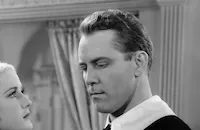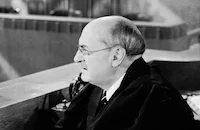Blackwell's Island

Brief Synopsis
Cast & Crew
William Mcgann
John Garfield
Rosemary Lane
Dick Purcell
Victor Jory
Stanley Fields
Film Details
Technical Specs

Synopsis
Reporter Tim Haydon determines to expose Bull Bransom, a sadistic crime lord who wields power behind corrupt political boss Steve Cardigan. Bransom's specialty is extorting money from tugboat and steamship captains, and when one of them, Captain Pederson, refuses to pay, Bransom's men toss a bomb at his boat and send him to the hospital. Bransom's men next pay a visit to Pederson at the hospital to threaten the life of his family. When police officer Terry Walsh, who is guarding Pederson's room, interferes with their plans, the thugs beat him up. Terry recognizes his assailants, and his testimony, coupled with that of Pederson, convicts Bransom and his men. Bransom is sentenced to the prison at Blackwell's Island, where Warden Stuart Granger is biding his time until retirement. Cardigan warns the warden that unless Bransom is granted special privileges, he will never see his pension. Bransom then takes over the prison, designating the hospital as his private club while he extorts money from the inmates. After Pederson is murdered for testifying, Terry begins his own investigation into the crime, and Bransom sneaks off the island to eliminate Terry himself. When no clues relating to Terry's murder can be found, Tim gets himself sentenced to the island, where he witnesses Bransom's corruption first hand. Meanwhile, Thomas McNair, a new commissioner committed to reform, has been appointed, and is informed of Tim's undercover work. When Terry's sister Sunny visits Tim on the island, Bransom becomes suspicious and arranges for Tim's murder. Learning of Bransom's plans, Tim swims ashore, where he reports to McNair that he can supply the evidence to connect Bransom with Terry's murder. Tim, McNair and his men take the island by storm and depose Bransom's reign. In the confusion, Bransom makes a dash for freedom, but Tim catches him and later helps to convict him of Terry's murder.

Director
William Mcgann
Cast

John Garfield

Rosemary Lane

Dick Purcell

Victor Jory
Stanley Fields
Morgan Conway

Granville Bates
Anthony Averill

Peggy Shannon
Charles Foy
Norman Willis
Joe Cunningham

Milburn Stone
William Gould
Eddy Chandler
Wade Boteler

William Davidson
Walter Young

Leon Ames
James Spottswood
Lottie Williams
Raymond Bailey
Jimmy O'gatty
Jan Holm
George Offerman Jr.
Herbert Rawlinson
John Dilson
Vera Lewis
John Harron
Jack Gardner
Bob Perry
Charles Sullivan
Herman Marks
Jack Wise
James Blaine
George Guhl
Charles Seel
Frank Bruno
Sam Bernard
Billy Wayne
Al Herman
Dick Rich
Harry Cody
Gus Sonnenberg
Lew Harvey

Walter Miller
Robert Homans
Monte Vandergrift
Henry Otho
Will Morgan
Stevan Darrell
Eddie Foster
Dick Wessel
Harry Harvey
Sam Jackson
Chester Gan
Joseph De Stefani
Demetris Emanuel

Fred Malatesta
Crew
Elmer Decker
Stanley Fleischer
Leo F. Forbstein
Bryan Foy
Doug Gould
Leslie G. Hewitt
Sid Hickox
Lee Katz
Dave Marcus
Harry Seymour
Howard Shoup
Jack L. Warner
Crane Wilbur
Crane Wilbur

Videos
Movie Clip



Trailer
Film Details
Technical Specs

Articles
Blackwell's Island
The screenplay is set on an NYC waterfront ruled by protection racketeer Bull Bransom (Stanley Fields), an overbearing oaf unaccustomed to having his authority questioned, and therefore none too happy when his mouthpiece Cardigan (Morgan Conway) brings his attention to an expose authored by crusading young reporter Tim Haydon (John Garfield). Bransom pulls a few strings and gets Haydon fired; a rival paper soon takes him on, and the newsman picks up the gauntlet. His defiance brings admiration from the honest young cop Terry Walsh (Dick Purcell) and his corrupted superior Capt. Pederson (Wade Boteler), fed up with living in Bull's pocket. With their testimony, Bransom draws a six-month stretch in Blackwell's for bribery.
Tim's satisfaction, however, is short-lived; having paid off the warden (Granville Bates), Bull has the run of the prison, fully able and very ready to engineer his revenge against those who sent him up. After Pederson and Terry turn up murdered, Haydon--who has already fallen for Walsh's sister Sunny (Rosemary Lane)--contrives to get himself convicted and sent to the island, so he can witness firsthand--and hopefully expose--the by-products of Bransom's graft.
The production history of Blackwell's Island offered intrigues at least as interesting as anything that played out onscreen. The second Warner assignment for freshly-signed contractee Garfield, the B film was strictly for the purpose of gauging his success as a lead. However, the film was in post-production when Garfield's debut project Four Daughters (1938) hit theaters; after critics and audiences alike declared him to have walked away with the picture, Warners okayed $100,000 for the lensing of additional sequences (directed by an uncredited Michael Curtiz) to bring Blackwell's to an "A" gloss worthy of their hot new talent. Blackwell's Island didn't reach audiences until after the release of Garfield's first bona fide A project as star, They Made Me a Criminal (1939).
The location shoot--and re-shoot--at the actual Blackwell's sat well with Lower East Side native Garfield, who'd already become homesick for his pregnant wife and for the stage. As recounted in Larry Swindell's bio Body and Soul: The Story of John Garfield, "'This isn't acting,' Julie said while Blackwell's Island was being filmed, 'this is what's called racing with the clock.'" In Robert Sklar's analysis City Boys: Cagney, Bogart, Garfield, Sklar found that Garfield seemed to have been instructed to channel Cagney in his performance; he noted that the response to Four Daughters ensured that he'd never have to do so again. "To represent New York's young men, Garfield no longer needed to be Cagney. He could now be himself--or rather, his new screen self--and stand for the boys and men of the later 1930s as Cagney had for the earlier."
The project had its genesis in the 1934 raid engineered by Fiorello LaGuardia in response to a cycle of corruption and scandal that had dogged the penitentiary from the early 1900s. The action led to the transfer of the inmate population to the just-completed Rikers Island, and "Welfare Island"--as cosmetically rechristened by the city back in 1921--was solely purposed toward the care of the aged and infirm until the beginning of its renaissance in the late '60s.
Producers: Hal B. Wallis, Jack L. Warner (uncredited)
Director: William McGann; Michael Curtiz (uncredited)
Screenplay: Crane Wilbur (screenplay and story); Lee Katz (story)
Cinematography: Sid Hickox
Art Direction: Stanley Fleischer
Music: Bernhard Kaun (uncredited)
Film Editing: Doug Gould
Cast: John Garfield (Tim Haydon), Rosemary Lane (Mary 'Sunny' Walsh), Dick Purcell (Terry Walsh), Victor Jory (Commissioner Thomas MacNair), Stanley Fields ('Bull' Bransom), Morgan Conway (Steve Cardigan), Granville Bates (Prison Warden Stuart 'Stu' Granger), Anthony Averill (Brower, a Henchman), Peggy Shannon (Pearl Murray), Charles Foy (Benny Farmer).
BW-71m. Closed Captioning.
by Jay Steinberg

Blackwell's Island
Quotes
Trivia
The first press screening was held at the Welfare Island Prison.
Notes
An early draft of Screen Achievements Bulletin credited Dave Marcus with original screenplay, but his name was eliminated from later drafts, and the extent of his participation in the final film has not been determined. According to the Variety review, this story was inspired by Austin MacCormick's 1934 raid on the Welfare Island prison, which revealed that gangster Joe Rao was in total command of the facility. A news item in Hollywood Reporter notes that Warner Bros. held its first press showing at Welfare Island.















